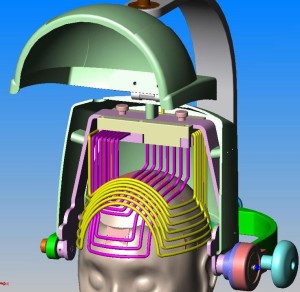The brain changes across lifespan. Its structure and functions are modified through mechanism known as brain plasticity. Research is showing that the brain undergoes complex modification from birth till death. These modifications refer to changes in neural pathways and synapses resulting from changes in behavior, environment, neural processes, thinking, and emotions. Stress as well as bodily injuries also affects the brain structures and functions. Similarly, as each magnetic pulse passes through the skull and into the brain, this produces changes in neuronal activities in regions exposed to changes in magnetic field. 
In addition to the location of the area exposed to the field changes, the frequency of pulse delivery also influences brain activity. Studies also suggest that stimulation over the left and right sides of the brain may differently effects mood regulation.
At the physiology level, brain consists of neurons communicating through firing signals to other neurons wired to them. A single TMS pulse affects a large pool of neurons, by creating a perturbative effects that allow area-selective manipulation of immediate cortical functions. One of the way the magnetic field generates a perturbation is through the induced eddies-like current. This single step affects how a neuron starts a spike firing. A repetitive application of the TMS signals further modifies the changes. These changes are nonlinear and complex, but their effect on modulating the firing sequence of the neurons can be described by “Cells that fire together wire together, cells that are out of synch, lose their link”. Applying TMS allows us to modify mood through what can be roughly described as modulating and coupling/decoupling pools of neurons with the objective to change the behavior. In case of depression we want to calm the brain. Treatment protocols validated by multiple-site thorough clinical studies provide a guidance how to perform the procedure.
Until recently, pharmacology has been a leading treatment option. FDA approval of TMS offers new treatment alternatives for patient and doctors. Non-invasive brain stimulation become an active research area. New approaches are investigated and reported of having impact on mood modification. A list of potential candidates for brain stimulation include, MRI-like low level stimulation, current-based brain stimulation, focused ultrasound brain stimulation. Today, after years of clinical tests, only TMS is so far approved by FDA for the clinical use.